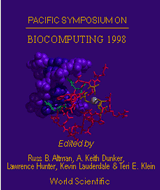Recognizing protein binding sites using statistical descriptions of their 3D environments
Wei L, Altman RB
Section on Medical Informatics, Stanford University, CA 94305-5479, USA. wei@smi.stanford.edu
Pac Symp Biocomput. 1998;:497-508.

Abstract
We have developed a new method for recognizing sites in three-dimensional protein structures. Our method is based on our previously reported algorithm for creating descriptions of protein microenvironments using physical and chemical properties at multiple levels of detail (including features at the atomic, chemical group, residue, and secondary structural levels). The recognition method takes three inputs: a set of sites that share some structural or functional role, a set of control nonsites that lack this role, and a single query site. The values of properties for the query site are compared to the distributions of values for both sites and nonsites to determine the group to which it is most similar. A log-odds scoring function, based on Bayes' Rule, computes a score that indicates the likelihood that the query region is a site of interest. In this paper, we apply the method to the task of identifying calcium binding sites in proteins. Cross-validation analysis shows that this recognition approach has high sensitivity and specificity. We also describe the results of scanning four calcium binding proteins (with the calcium removed) using a three-dimensional grid of probe points at 2 A spacing. The probe points that have high scores cluster around the true calcium binding sites, with the highest scoring points at or near the binding sites. The method fails in only one case where a calcium binding site is created by four proteins in the crystal lattice, and is thus not recognizable within the crystallographic asymmetric unit. Our results show that property-based descriptions can be used for recognizing protein sites in unannotated structures.
[Full-Text PDF] [PSB Home Page]